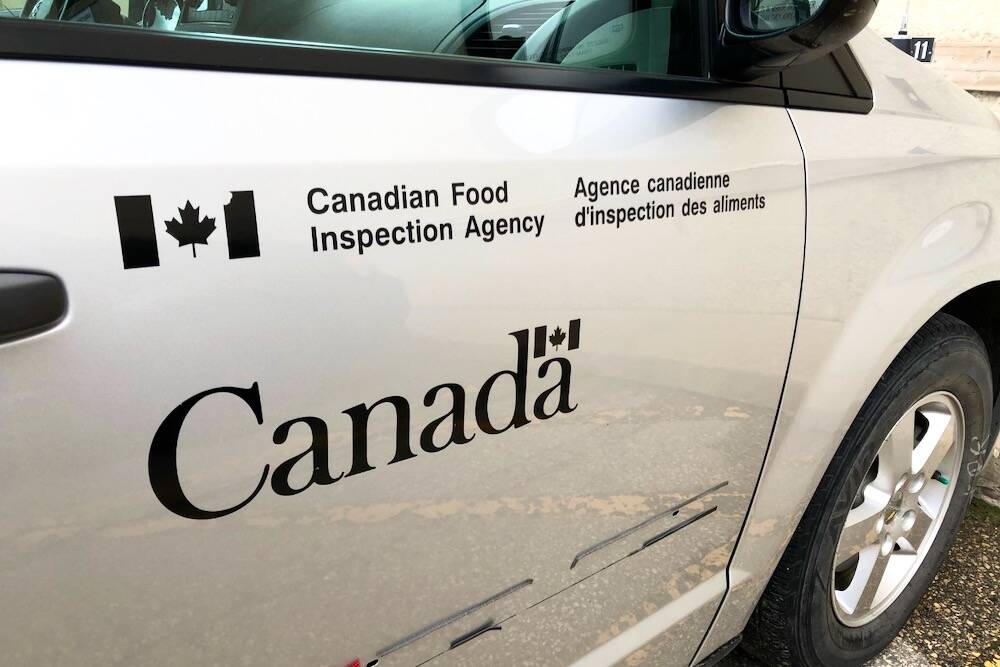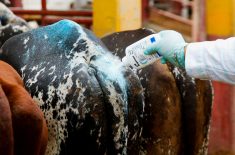Manitoba’s provincial government has indefinitely extended a moratorium on new or expanded hog operations in the province’s main livestock corridor and points north.
The decision, which drew immediate criticism from the province’s hog producers’ group, follows the long-awaited release Monday of the provincial Clean Environment Commission’s (CEC) report on the environmental sustainability of Manitoba’s hog industry.
That sustainability is achievable, the report said, “but it cannot be put off into the
Read Also

B.C. ostriches now to be culled after ruling: CFIA
Birds are now to be culled from a British Columbia ostrich operation that sought to bypass standard federal practice in on-farm outbreaks of highly pathogenic avian influenza and has been denied an appeal at Canada’s highest court.
will be to develop an implementation
strategy that works with producers and
other members of society to ensure the
industry’s social and economic sustainability.
“In those areas where nutrient production
is currently out of balance with the
environment’s ability to remove those
nutrients, the province and producers must
move quickly and cooperatively to bring
production into balance within the next five
years.”
Provincial Conservation Minister Stan Struthers said the province accepts “in principle” the CEC’s 48 recommendations and would launch an action plan in response. The first move halts expansion in three regions in the eastern half of the province “where enhancement of existing environmental protection is necessary.”
The first of the three moratoriums cover Manitoba’s southeastern “hog alley”: the rural municipalities of La Broquerie, Ste. Anne, Hanover and De Salaberry. The RMs, all east of the Red River, surround the city of Steinbach and communities such as St. Pierre Jolys.
The second is a designated Red River “special management zone” including Winnipeg as well as the “capital region” around it. Affected RMs, which surround the Red and Assiniboine rivers, include St. Clements, St. Andrews, Rockwood, Rosser, East St. Paul, West St. Paul, Headingley, St. Francois Xavier, Ritchot, Springfield, Cartier, MacDonald, Tache, Montcalm and Morris and parts of the RMs of Portage la Prairie, Grey, Dufferin, Roland, Franklin and Rhineland.
The third affected region, in the Interlake between Lakes Winnipeg and Manitoba, freezes new hog barn development or expansion in the RMs of Woodlands, St. Laurent, Gimli, Coldwell, Armstrong, Bifrost, Fisher, Eriksdale, Grahamsdale and Siglunes.
At a news conference in Winnipeg Monday, before which the report was released to media under the type of embargo usually reserved for the provincial budget, Struthers said the province would also take “immediate action” on a CEC recommendation that it finalize contingency plans to deal with a U.S. border closure.
Theoretically such a closure, whether imposed out of disease concerns or “politically-motivated” action such as U.S. country-of-origin labeling (COOL), would prevent Manitoba from exporting hogs and force it to raise more within the province.
“Absolutely opposed”
Expansion or development of hog barns is, for now, largely a moot point across Manitoba and Canada, due to the rising dollar, high feed costs and low returns on hogs. The federal government and Canadian Pork Council plan a $50 million cull of breeding sows to reduce Canada’s breeding herd by up to 10 per cent.
That said, Manitoba Pork Council president Karl Kynoch said his group is “absolutely opposed to this permanent moratorium being imposed on two-thirds of hog farmers in Manitoba.
“We cannot understand how the government could spend all of this time, money and effort on a major CEC review and report,
where the industry was analyzed in depth by experts and the public, and then bans new barn construction — despite the fact that the CEC did not recommend a continuation of the moratorium. This is simply bad public policy, made for the wrong reasons,” said Kynoch, who farms at Baldur, Man., well outside the three affected regions.
“Previous government studies have shown the hog industry contributes only about 1.5 per cent to the pollution in Lake Winnipeg — the other 98.5 per cent comes from other sources,” he said in a release Monday.
“Where is the ban on septic fields? Where is the ban on new cottages? Where is the ban on new houses in Winnipeg? What about chemical fertilizers? And what about other industries and other livestock producers? Why is the hog industry being singled out when it is such a small contributor to the overall problem?”
Among opposition politicians, provincial Liberal leader Jon Gerrard applauded CEC recommendations such as a provincewide ban on winter spreading of hog manure.
However, he said, given the hog sector’s financial straits, “there must be government assistance for farmers to make the environmentally conscious choice and it is crucial that we work with people in industries to better understand the issues and to produce a plan that is supported by all parties.”
MPC’s Kynoch said smaller farmers, in particular, will be least able to absorb the added costs of new regulations.
Recommendations
Among the report’s major recommendations to the province, apart from a long list of further longer-term study, research and data collection projects on issues such as phosphorus loading, manure-borne pathogens, odour, antibiotic use and resistance and others, are:
- adjusting the province’s Livestock Manure and Mortalities Management Regulation (LMMMR) phosphorus provisions to enforce compliance along all hog producers by 2013
- extension of the LMMMR ban on winter application of manure to all hog operations by 2013 — and encouraging hog management that leads to maximum manure supplies and applications in spring and summer
- a provincial contingency plan to address the animal welfare consequences of a border closing, and help for producers to develop contingency plans for a “catastrophic event resulting in mass mortalities”
- funding to help hog farmers comply with LMMMR phosphorus provisions, such as to put beneficial management practices in place
- amending the LMMMR to require new and expanding operations to demonstrate they have enough cropland available to balance long-term application and removal rates
- requiring new above-ground steel or concrete storage facilities to be built inside dikes that can hold 110 per cent of the facility’s capacity
- requiring all new, modified, or expanding hog operations to register manure management plans
- requiring all new manure storage facilities to have synthetic covers
- requiring new and expanding operations to either inject or incorporate manure
- ending the $50 deposit requirement for anyone to file a complaint to the provincial Farm Practices Protection Board
- a new “dispersion-theory-based” farm odour guideline
- buffer zones banning manure application around sensitive sites such as tall and mixed grass prairie remnants
- an approval process for new, modified and expanding manure storage facilities to be screened by a provincial technical advisory committee, leaving land-use issues with municipalities and environmental approval authority with the province
- development of a “nutrient budget” for agricultural Manitoba on a sub-watershed and, ultimately, a watershed basis
- development of a common database to record the presence of all Manitoba livestock operations
- a new Watershed Studies Institute to co-ordinate information collection and evaluation and direct research on watershed management in Manitoba
The province commissioned the CEC report in November 2006 and imposed a provincewide “pause” on new development in the hog sector while the commission’s work was underway. The commission held 20 public meetings across the province through 2007.










